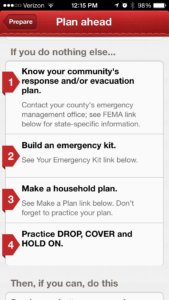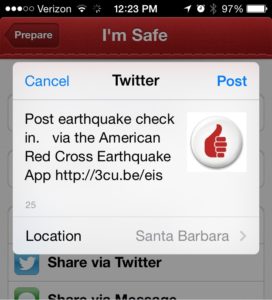That’s a pretty downer blog title, right?
With the two moderate earthquakes that hit Southern California this in the past few weeks, I was asked to write a blog post about earthquake preparedness – the task seemed simple enough until my husband and I started diving into some serious planning questions.
I went through the Red Cross Earthquake App and as I poked through the “Plan Ahead” section. I’ve practiced DROP, COVER, and HOLD ON quite a few times, so I felt ready for that, and our emergency kit is pretty much in order (it will get refreshed/updated this weekend).
However, things got a little tough once we looked at our area’s potential hazards, and our attempt to come up with plans based on this is where things got downright sticky. Oh, and as were were talking through this, we learned that there was an 8.2 earthquake that struck off the coast of Chile.
 You see, our town can actually be CUT OFF from the surrounding areas if there is a major earthquake. The one freeway that connects us to the towns north and south can collapse on either side, and the small highway that leads east can also be lost – literally cutting us off. My husband works 35 minutes away, and I work from home, so if “the big one” hit during work hours and the bridge to the south collapsed, we would be separated for an undetermined period of time.
You see, our town can actually be CUT OFF from the surrounding areas if there is a major earthquake. The one freeway that connects us to the towns north and south can collapse on either side, and the small highway that leads east can also be lost – literally cutting us off. My husband works 35 minutes away, and I work from home, so if “the big one” hit during work hours and the bridge to the south collapsed, we would be separated for an undetermined period of time.
It’s easy to make a plan for when we’re both home – his job is to turn off the gas, my job is to pull out the emergency supply kit, and we will probably shelter in place until we get more information from our battery-powered radio – but we were suddenly faced with asking ourselves what we were going to do as individuals if we were separated and there was no way for us to have a meeting place outside of town if there was no way for me to get out of town (because when we tried to fill in the “out of town” meeting place in the app, we were stuck).
This meant that in addition to a family plan, we BOTH needed to have a personal earthquake response plan. This means that we’re going to put a mini kit in my husband’s car to include running shoes/change of clothes (no one wants to be running around after an earthquake in a business suit), water, food, and some bare necessities to help him get by until he can get to a shelter since he most likely will not be able to get home for a few days. I will (most likely) still need to shelter in place, but then we will need a communication plan. Cell towers may be destroyed or overwhelmed, so do we let the other know we’re safe via text or social media?
 This same scenario can happen to families – what if you’re at work and your kids are at school when an earthquake hits and you can’t get home to your meeting spot? Do your kids know what to do? Is there another place they can go until you can meet up?
This same scenario can happen to families – what if you’re at work and your kids are at school when an earthquake hits and you can’t get home to your meeting spot? Do your kids know what to do? Is there another place they can go until you can meet up?
Preparedness can be a lifesaving exercise if everyone knows what to do in any given situation, but preparedness goes far beyond having a kit and ONE PLAN. The Earthquake App wasn’t just a great tool for us to put a “base plan” together with the assumption that we’ll both be in the house when an earthquake strikes, it was also a good conversation piece for us to walk through some of the “worst case” scenarios and what we may have to do as individuals to survive until we can be reunited.
While having to face the possibility that we may be separated by an earthquake was nerve wracking, actually taking charge and creating a PLAN for each of us made me feel better – I now know what my husband will be doing if we’re separated and he knows what I’ll be doing, and I’ve found in disaster situations, the more “what if” you can conquer, the more in control you’ll feel if something happens.

